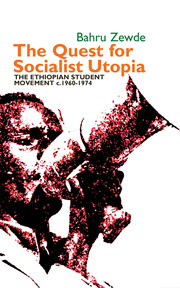Book contents
- Frontmatter
- Dedication
- Contents
- List of Illustrations
- Acronyms
- Abbreviations
- Glossary
- Note on Transliteration
- Note on the Ethiopian Calendar
- Acknowledgements
- Introduction
- 1 Youth in Revolt
- 2 The Political and Cultural Context
- 3 In the Beginning: ‘That Will Be the Day, When …’
- 4 The Process of Radicalization
- 5 1969: Prelude to Revolution
- 6 Championing the Cause of the Marginalized: The National Question and the Woman Question
- 7 Fusion and Fission: From Student Unions to Leftist Political Organizations
- 8 Conclusion: The Legacy
- Bibliography
- Index
6 - Championing the Cause of the Marginalized: The National Question and the Woman Question
Published online by Cambridge University Press: 05 April 2014
- Frontmatter
- Dedication
- Contents
- List of Illustrations
- Acronyms
- Abbreviations
- Glossary
- Note on Transliteration
- Note on the Ethiopian Calendar
- Acknowledgements
- Introduction
- 1 Youth in Revolt
- 2 The Political and Cultural Context
- 3 In the Beginning: ‘That Will Be the Day, When …’
- 4 The Process of Radicalization
- 5 1969: Prelude to Revolution
- 6 Championing the Cause of the Marginalized: The National Question and the Woman Question
- 7 Fusion and Fission: From Student Unions to Leftist Political Organizations
- 8 Conclusion: The Legacy
- Bibliography
- Index
Summary
We believe that the support of the right to secession will, by itself, discourage secession.
There is general consensus that the driving force behind the Ethiopian student movement was rejection of oppression in all its forms. The protests and demonstrations that started to peak after 1965 were directed against one manifestation or another of that oppression. The ‘Land to the Tiller’ demonstration of 1965 had as its objective economic and social equity in the exploitation of the country's most important social and economic asset – land. In 1966, students rose in defence of the poor who were herded in shelters that were considered sub-human. The 1967 demonstration was in protest at the curtailment of the freedom of expression and assembly. The nation-wide protests of 1969, under the slogan of ‘Education for All’ drew attention to the increasing constraints placed on the poor sectors of society in educating their children. It is not surprising, therefore, that, starting in that same year, students began to turn their attention to two major glaring manifestations of social inequality: the oppression of nationalities and of women. That was the genesis of the two questions that came to have a prominent place in the student movement in the 1970s: the national question and the woman question.
THE NATIONAL QUESTION
Historical background
What was variously referred to as ‘the national question’ or ‘the question of nationalities’ came to be a predominant concern in the Ethiopian student movement in the late 1960s and early 1970s. As we now know, it has become a cardinal element of the political ideology and configuration of post-1991 Ethiopia.
- Type
- Chapter
- Information
- The Quest for Socialist UtopiaThe Ethiopian Student Movement, c. 1960-1974, pp. 187 - 228Publisher: Boydell & BrewerPrint publication year: 2014



